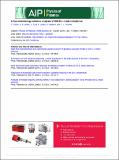| dc.contributor.author | Görler, T. | |
| dc.contributor.author | Told, D. | |
| dc.contributor.author | Jenko, F. | |
| dc.contributor.author | Holland, C. | |
| dc.contributor.author | Rhodes, T. L. | |
| dc.contributor.author | White, Anne E. | |
| dc.date.accessioned | 2015-03-05T20:37:02Z | |
| dc.date.available | 2015-03-05T20:37:02Z | |
| dc.date.issued | 2014-12 | |
| dc.date.submitted | 2014-09 | |
| dc.identifier.issn | 1070-664X | |
| dc.identifier.issn | 1089-7674 | |
| dc.identifier.uri | http://hdl.handle.net/1721.1/95896 | |
| dc.description.abstract | Previous nonlinear gyrokinetic simulations of specific DIII-D L-mode cases have been found to significantly underpredict the ion heat transport and associated density and temperature fluctuation levels by up to almost one of order of magnitude in the outer-core domain, i.e., roughly in the last third of the minor radius. Since then, this so-called shortfall issue has been subject to various speculations on possible reasons and furthermore motivation for a number of dedicated comparisons for L-mode plasmas in comparable machines. However, only a rather limited number of simulations and gyrokinetic codes has been applied to the original scenario, thus calling for further dedicated investigations in order to broaden the scientific basis. The present work contributes along these lines by employing another well-established gyrokinetic code in a numerically and physically comprehensive manner. Contrary to the previous studies, only a mild underprediction is observed at the outer radial positions which can furthermore be overcome by varying the ion temperature gradient within the error bars associated with the experimental measurement. The significance and reliability of these simulations are demonstrated by benchmarks, numerical convergence tests, and furthermore by extensive validation studies. The latter involve cross-phase and cross-power spectra analyses of various fluctuating quantities and confirm a high degree of realism. The code discrepancies come as a surprise since the involved software packages had been benchmarked repeatedly and very successfully in the past. Further collaborative effort in identifying the underlying difference is hence required. | en_US |
| dc.description.sponsorship | European Union. Horizon 2020 Research and Innovation Programme (Grant 633053) | en_US |
| dc.language.iso | en_US | |
| dc.publisher | American Institute of Physics (AIP) | en_US |
| dc.relation.isversionof | http://dx.doi.org/10.1063/1.4904301 | en_US |
| dc.rights | Article is made available in accordance with the publisher's policy and may be subject to US copyright law. Please refer to the publisher's site for terms of use. | en_US |
| dc.source | Other univ. web domain | en_US |
| dc.title | A flux-matched gyrokinetic analysis of DIII-D L-mode turbulence | en_US |
| dc.type | Article | en_US |
| dc.identifier.citation | Görler, T., A. E. White, D. Told, F. Jenko, C. Holland, and T. L. Rhodes. “A Flux-Matched Gyrokinetic Analysis of DIII-D L-Mode Turbulence.” Phys. Plasmas 21, no. 12 (December 2014): 122307. © 2014 EURATOM | en_US |
| dc.contributor.department | Massachusetts Institute of Technology. Department of Nuclear Science and Engineering | en_US |
| dc.contributor.mitauthor | White, Anne E. | en_US |
| dc.relation.journal | Physics of Plasmas | en_US |
| dc.eprint.version | Final published version | en_US |
| dc.type.uri | http://purl.org/eprint/type/JournalArticle | en_US |
| eprint.status | http://purl.org/eprint/status/PeerReviewed | en_US |
| dspace.orderedauthors | Görler, T.; White, A. E.; Told, D.; Jenko, F.; Holland, C.; Rhodes, T. L. | en_US |
| dc.identifier.orcid | https://orcid.org/0000-0003-2951-9749 | |
| mit.license | PUBLISHER_POLICY | en_US |
| mit.metadata.status | Complete | |
